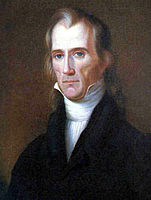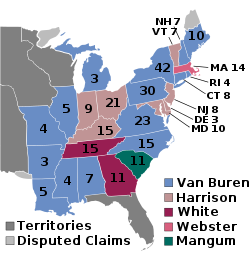| ||||||||||||||||||||||||||
| ||||||||||||||||||||||||||
 County results
| ||||||||||||||||||||||||||
| ||||||||||||||||||||||||||
| Elections in Tennessee |
|---|
 |
The 1836 United States presidential election in Tennessee was held on November 7, 1836 as part of the 1836 United States presidential election. [1] Voters chose 15 representatives, or electors, to the Electoral College, who voted for President and Vice President.
Contents
The Whig Party, unable to agree on a candidate, ran four candidates against Democratic nominee Martin Van Buren: Hugh Lawson White, William Henry Harrison, Daniel Webster, and Willie Person Mangum. Tennessee Senator Hugh Lawson White was the Whig Party nominee in Tennessee.
During the campaign trail, Andrew Jackson actively campaigned against White in Tennessee and accused him of being a Federalist who was opposed to states' rights. [2]
In spite of opposition from Jackson, Tennessee Whig nominee White won Tennessee, defeating Democratic nominee Van Buren, by a margin of 15.84%.
White also won Georgia, giving him 26 electoral votes, the third highest total behind Van Buren's 170, and Harrison's 73. [3]


